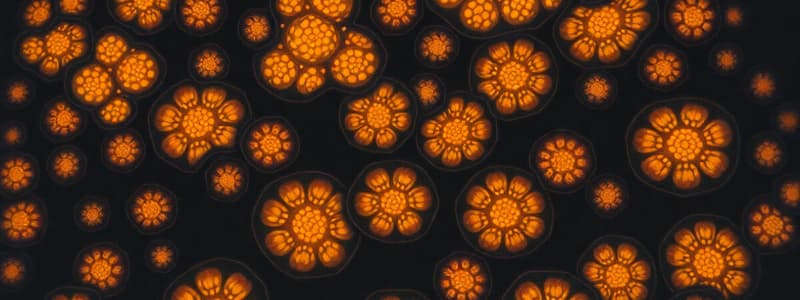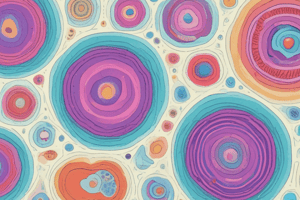Podcast
Questions and Answers
What is the primary function of ceramides in eukaryotic cells?
What is the primary function of ceramides in eukaryotic cells?
- They synthesize cellular proteins.
- They provide energy for cellular metabolism.
- They form structural components of cell membranes. (correct)
- They transport solutes across the membrane.
Where is the majority of cellular cholesterol found?
Where is the majority of cellular cholesterol found?
- In the plasma membrane. (correct)
- In the mitochondria.
- In the endoplasmic reticulum.
- Within cytosolic vesicles.
What are the primary components synthesized on the cytosolic side of the ER membrane?
What are the primary components synthesized on the cytosolic side of the ER membrane?
- Nucleic acids and ribosomes.
- Proteins and carbohydrates.
- Phospholipids from glycerol and fatty acids. (correct)
- Cholesterol and sphingomyelin.
What role do carrier proteins play in eukaryotic cells?
What role do carrier proteins play in eukaryotic cells?
Which of the following phospholipids is formed directly from phosphatidic acid?
Which of the following phospholipids is formed directly from phosphatidic acid?
What characterizes rough endoplasmic reticulum (RER)?
What characterizes rough endoplasmic reticulum (RER)?
Which function is NOT associated with smooth endoplasmic reticulum (SER)?
Which function is NOT associated with smooth endoplasmic reticulum (SER)?
Which type of cell would most likely have a well-developed smooth endoplasmic reticulum?
Which type of cell would most likely have a well-developed smooth endoplasmic reticulum?
What is one of the metabolic functions of smooth endoplasmic reticulum in liver cells?
What is one of the metabolic functions of smooth endoplasmic reticulum in liver cells?
What is the main structural characteristic of endoplasmic reticulum?
What is the main structural characteristic of endoplasmic reticulum?
Which lipid is NOT synthesized by the endoplasmic reticulum?
Which lipid is NOT synthesized by the endoplasmic reticulum?
What distinguishes the smooth endoplasmic reticulum (SER) from the rough endoplasmic reticulum (RER)?
What distinguishes the smooth endoplasmic reticulum (SER) from the rough endoplasmic reticulum (RER)?
Ceramides are composed of which two components?
Ceramides are composed of which two components?
What is the primary role of actin and myosin in muscle cells?
What is the primary role of actin and myosin in muscle cells?
What is the significance of the sarcomeric Z-disc?
What is the significance of the sarcomeric Z-disc?
Which protein undergoes a structural change upon binding to calcium ions?
Which protein undergoes a structural change upon binding to calcium ions?
What initiates the process of muscle contraction?
What initiates the process of muscle contraction?
How does myosin contribute to muscle contraction?
How does myosin contribute to muscle contraction?
What effect do calcium ions have on tropomyosin?
What effect do calcium ions have on tropomyosin?
Which statement about actin and myosin filaments is correct?
Which statement about actin and myosin filaments is correct?
What role does the sarcoplasmic reticulum play in muscle contraction?
What role does the sarcoplasmic reticulum play in muscle contraction?
What is the primary function of the cytochrome P450 enzyme system in liver hepatocytes?
What is the primary function of the cytochrome P450 enzyme system in liver hepatocytes?
Which enzyme is specifically involved in the breakdown of glycogen into glucose in the liver?
Which enzyme is specifically involved in the breakdown of glycogen into glucose in the liver?
What is one of the main ways lipids leave the smooth endoplasmic reticulum (SER)?
What is one of the main ways lipids leave the smooth endoplasmic reticulum (SER)?
Granular endoplasmic reticulum (GER) is predominantly involved in which cellular process?
Granular endoplasmic reticulum (GER) is predominantly involved in which cellular process?
In which type of cells is granular endoplasmic reticulum (GER) particularly well developed?
In which type of cells is granular endoplasmic reticulum (GER) particularly well developed?
Which of the following types of proteins is NOT synthesized in the granular endoplasmic reticulum (GER)?
Which of the following types of proteins is NOT synthesized in the granular endoplasmic reticulum (GER)?
Which of the following statements about the rough endoplasmic reticulum (RER) is true?
Which of the following statements about the rough endoplasmic reticulum (RER) is true?
What is the main source of fuel for cells when not stored as glycogen?
What is the main source of fuel for cells when not stored as glycogen?
What is the primary destination for proteins that have a signal peptide during synthesis?
What is the primary destination for proteins that have a signal peptide during synthesis?
What initiates the halt in protein synthesis during the targeting process?
What initiates the halt in protein synthesis during the targeting process?
Which component is responsible for returning to the cytosol after attaching to the ribosome?
Which component is responsible for returning to the cytosol after attaching to the ribosome?
What is the function of the GTP binding during the protein targeting process?
What is the function of the GTP binding during the protein targeting process?
Which of the following conditions leads to the synthesis of proteins in the cytoplasm on free ribosomes?
Which of the following conditions leads to the synthesis of proteins in the cytoplasm on free ribosomes?
What is the approximate length of the signal peptide that is crucial for ER targeting?
What is the approximate length of the signal peptide that is crucial for ER targeting?
What is the role of ribophorin proteins in the ER?
What is the role of ribophorin proteins in the ER?
Which of the following proteins is responsible for docked ribosomes during protein synthesis?
Which of the following proteins is responsible for docked ribosomes during protein synthesis?
What is the initial state of proteins as they are translocated across the ER membrane?
What is the initial state of proteins as they are translocated across the ER membrane?
What role do molecular chaperones play in the ER?
What role do molecular chaperones play in the ER?
Which chaperone is responsible for binding to unfolded polypeptides during translocation?
Which chaperone is responsible for binding to unfolded polypeptides during translocation?
What is the significance of disulfide bonds in protein processing in the ER?
What is the significance of disulfide bonds in protein processing in the ER?
What happens to improperly assembled proteins in the ER?
What happens to improperly assembled proteins in the ER?
How do proteins travel from the ER to the Golgi apparatus?
How do proteins travel from the ER to the Golgi apparatus?
What must occur for proteins to be correctly released from the ER?
What must occur for proteins to be correctly released from the ER?
What type of molecules are transported from the ER to the Golgi apparatus?
What type of molecules are transported from the ER to the Golgi apparatus?
Flashcards
Endoplasmic Reticulum (ER)
Endoplasmic Reticulum (ER)
A network of membrane-enclosed tubules and sacs in eukaryotic cells, extending from the nuclear membrane throughout the cytoplasm.
Rough ER
Rough ER
Part of the ER studded with ribosomes, involved in protein synthesis, processing, and quality control.
Smooth ER
Smooth ER
Part of the ER lacking ribosomes, involved in lipid synthesis, metabolism, and detoxification.
Lipid synthesis
Lipid synthesis
Signup and view all the flashcards
Phospholipids
Phospholipids
Signup and view all the flashcards
Steroid hormones
Steroid hormones
Signup and view all the flashcards
Detoxification
Detoxification
Signup and view all the flashcards
Sarcoplasmic Reticulum
Sarcoplasmic Reticulum
Signup and view all the flashcards
Ceramides in Cell Membranes
Ceramides in Cell Membranes
Signup and view all the flashcards
Cholesterol Location
Cholesterol Location
Signup and view all the flashcards
Smooth ER Lipid Synthesis
Smooth ER Lipid Synthesis
Signup and view all the flashcards
Vesicle Function
Vesicle Function
Signup and view all the flashcards
Phospholipid Synthesis
Phospholipid Synthesis
Signup and view all the flashcards
Actin and Myosin
Actin and Myosin
Signup and view all the flashcards
Sarcomere
Sarcomere
Signup and view all the flashcards
Z-disc
Z-disc
Signup and view all the flashcards
Muscle Contraction
Muscle Contraction
Signup and view all the flashcards
Motor Neuron
Motor Neuron
Signup and view all the flashcards
Acetylcholine
Acetylcholine
Signup and view all the flashcards
Troponin and Tropomyosin
Troponin and Tropomyosin
Signup and view all the flashcards
Cross-bridges (actin-myosin)
Cross-bridges (actin-myosin)
Signup and view all the flashcards
Cytochrome P450 enzymes location
Cytochrome P450 enzymes location
Signup and view all the flashcards
Glycogen breakdown in liver
Glycogen breakdown in liver
Signup and view all the flashcards
Non-vesicular lipid transport
Non-vesicular lipid transport
Signup and view all the flashcards
Rough ER (RER) & protein synthesis
Rough ER (RER) & protein synthesis
Signup and view all the flashcards
GER function in cells
GER function in cells
Signup and view all the flashcards
Types of proteins made by GER
Types of proteins made by GER
Signup and view all the flashcards
SER lipid transport proteins
SER lipid transport proteins
Signup and view all the flashcards
SER & Vesicular transport
SER & Vesicular transport
Signup and view all the flashcards
Signal Hypothesis
Signal Hypothesis
Signup and view all the flashcards
Signal Peptide
Signal Peptide
Signup and view all the flashcards
SRP (Signal Recognition Particle)
SRP (Signal Recognition Particle)
Signup and view all the flashcards
Protein Translocon
Protein Translocon
Signup and view all the flashcards
Free Ribosomes
Free Ribosomes
Signup and view all the flashcards
Cytosol
Cytosol
Signup and view all the flashcards
SRP Receptor (Docking Protein)
SRP Receptor (Docking Protein)
Signup and view all the flashcards
Ribosome Targeting
Ribosome Targeting
Signup and view all the flashcards
Protein translocation (ER)
Protein translocation (ER)
Signup and view all the flashcards
Protein folding (ER)
Protein folding (ER)
Signup and view all the flashcards
Disulfide bonds (ER)
Disulfide bonds (ER)
Signup and view all the flashcards
Quality control (ER)
Quality control (ER)
Signup and view all the flashcards
ER export
ER export
Signup and view all the flashcards
Protein transport pathway
Protein transport pathway
Signup and view all the flashcards
Vesicle formation
Vesicle formation
Signup and view all the flashcards
Protein cargo
Protein cargo
Signup and view all the flashcards
Study Notes
Endoplasmic Reticulum (ER) Structure and Function
- The ER is a network of membrane-enclosed tubules and sacs (cisternae) that extends from the nuclear membrane throughout the cytoplasm.
- It's the largest organelle in most eukaryotic cells.
- The ER can comprise greater than 10% of the total cell volume.
Types of ER
- Rough ER (RER) or Granular ER (GER): Covered by ribosomes on its outer surface.
- Involved in protein production, processing, folding, and quality control.
- Not associated with ribosomes.
- Smooth ER (SER) or Agranular ER:
- Tubular or vesicular in form.
- Not involved in protein synthesis.
- Functions in lipid metabolism in different cell types, including lipid synthesis, metabolism, muscle contraction, and detoxification.
SER Functions
- Lipid synthesis: Synthesizes phospholipids, cholesterol, and ceramide, the essential components of cell membranes.
- Steroid hormone biosynthesis: Synthesizes steroid hormones.
- Metabolism in liver cells: Metabolizes lipid-soluble compounds, harmful drugs, and alcohol, by converting them to water-soluble compounds for excretion in the urine.
- Muscle contraction: Participates in the contraction process in muscle cells as sarcoplasmic reticulum (SR).
- Lipid transport: Involved in lipid transport.
Phospholipids
- Phospholipids are a group of lipids that consist of two hydrophobic fatty acids, a hydrophilic glycerol unit, and a phosphate group which is esterified to an organic molecule (e.g., choline, ethanolamine, inositol).
Sphingolipids
- Ceramides are a family of waxy lipid molecules composed of sphingosine and a fatty acid.
- Ceramides are found in high concentrations within the cell membrane of eukaryotic cells.
- Component lipids of sphingomyelin, one of the major lipids in the lipid bilayer.
Cholesterol
- Cholesterol is a sterol (or modified steroid) lipid.
- More than 90% of cellular cholesterol is located at the plasma membrane.
- High cholesterol can lead to fatty deposits in blood vessels.
Smooth ER and Lipid Synthesis
- ER is the major site for synthesizing membrane lipids in eukaryotic cells.
- Membrane lipids are synthesized in association with already existing membranes (hydrophobic) rather than in the aqueous environment of the cytosol.
- Membrane lipids are then transported from the ER to their final destinations via vesicles or carrier proteins.
Smooth ER and Lipid Synthesis: Vesicles
- A vesicle is a structure within or outside a cell, consisting of liquid or cytoplasm enclosed by a lipid bilayer.
Smooth ER and Lipid Synthesis: Carrier Protein
- A carrier protein is a membrane protein that moves solutes across the membrane by creating conformational changes in the protein.
Smooth ER and Lipid Synthesis (Phospholipids): Chemical Process
- Most phospholipids are derived from glycerol.
- Synthesized on the cytosolic side of the ER membrane from water-soluble cytosolic precursors.
- Resulting phospholipid (e.g., phosphatidic acid) is inserted into the membrane.
- Enzymes on the cytosolic side of the ER membrane then modify phosphatidic acid or catalyze the addition of different polar head groups, including phosphatidyl choline, phosphatidyl serine, phosphatidyl ethanolamine, and phosphatidyl inositol.
- These are formed from phosphatidic acid via a modified diacylglycerol.
SER and Steroid Hormones
- SER contains the enzymes needed to synthesize steroid hormones, which are abundant in steroid-producing cells (e.g., Leydig's cells in testes, adrenal cortex cells, corpus luteum cells in ovaries).
- Steroid hormones are synthesized from cholesterol.
SR and Muscle Contraction
- SR (sarcoplasmic reticulum) is a smooth endoplasmic reticulum found within muscle cells.
- The main function of the SR is to store calcium ions (Ca2+).
- The SR specifically regulates Ca2+ ion flow; Ca2+ ions regulate muscular contraction.
- Ca2+ ions bind to the Troponin C component of the actin filament, exposing binding sites for the myosin head to bind to; this stimulates muscle contraction.
- SR membrane contains Ca2+-ATPase pumps.
- SR system consists of a branching network of SER cisternae surrounding each myofibril.
Types of Muscle
- Smooth muscle: Involuntarily contracts internal organs, blood vessels.
- Cardiac muscle: Involuntarily contracts in the heart.
- Skeletal muscle: Voluntarily contracts bones of the skeleton.
Muscle Structures
- Myocytes are muscle cells.
- Muscle tissue is composed of muscle fibers, which are bundles of tubular myofibrils.
- Myofibrils are composed of repeating sarcomeres.
- Sarcomeres are the functional units of a muscle fiber.
- Actin and myosin are two proteins found in all muscle tissue. Myosin (15nm) is a thick filament, and actin (7nm) is a thinner filament.
- Contraction is driven by the interaction of actin and myosin filaments.
Muscle Contractions
- Actin and myosin work together for muscle contraction and movement; a motor neuron releases acetylcholine into the muscle cell.
- Acetylcholine triggers the release of calcium ions from the sarcoplasmic reticulum.
- Calcium ions bind to troponin, changing its shape and moving tropomyosin away from the myosin-binding sites on actin.
- Myosin heads bind to actin, forming cross-bridges.
- Myosin pulls actin filaments towards the center of the sarcomere (ATP energy).
- The sarcomere shortens, causing the muscle fiber to contract.
SER and Liver Metabolic Reactions
- Abundant in the liver, SER contains specific enzymes that metabolize lipid-soluble compounds and inactivates harmful drugs (e.g., phenobarbital), converting them into water-soluble compounds that are eliminated via the urine.
- Also detoxifies alcohol and certain toxic compounds, certain hormones.
- Cytochrome P450 is a large family of enzymes in the SER of liver cells; plays a significant role in drug metabolism.
Glycogen Breakdown
- SER membranes contain Glucose-6-phosphatase in the liver.
- This enzyme is involved in breaking down glycogen into glucose.
ER in Protein Synthesis
- GER: Involved in protein synthesis and secretion.
- Prominent in cells specialized for protein synthesis.
- Ribosomes: Attached to the GER's exterior.
- Detected by light microscope by staining basic dyes
- Free ribosomes: Synthesize proteins destined to remain in the cytosol, nucleus, mitochondria, chloroplasts or peroxisomes.
Protein Synthesis in the GER(Detailed)
- All protein synthesis begins on free ribosomes in the cytosol, protein synthesis is resumed.
- Ribosomes synthesize secretory proteins and are subsequently targeted to the ER by a signal sequence (amino acid sequence) at the polypeptide chain's amino terminus.
- The signal sequence is about 16–20 amino acids long and appears at the beginning of the growing polypeptide chain.
- Signal peptides emerge; a special molecule (SRP; a protein-RNA complex) recognizes the sequence.
- SRP binds to the signal peptide and ribosome. Protein synthesis halts.
- SRP-ribosome complex attaches to the ER at specific sites (SRP receptors).
- SRP is released, and synthesis resumes.
- The growing polypeptide chain enters the translocon channel.
- The signal peptide is removed by signal peptidase.
- The polypeptide chain is released into the ER lumen.
- The ribosome detaches.
- Completed protein may be packaged into transport vesicles and move to Golgi. Further modifications may occur.
Post-translational Modifications
- Newly synthesized polypeptides in the ER undergo five modifications:
- Carbohydrate addition and processing
- Disulfide bond formation
- Specific proteolytic cleavages
- Protein folding
- Assembly into multimeric proteins
Protein Folding, Glycosylation
- ER is the site of protein folding, assembly, disulfide bond formation, and initial glycosylation steps (modification of proteins with carbohydrates).
- Luminal ER proteins' primary role is assisting newly translocated polypeptides' folding and assembly.
- Translocated proteins enter the ER as unfolded peptides.
- Chaperons (e.g., Bip/Hsp70) facilitate folding.
- Disulfide bond formation enhances protein stability.
Export from ER
- Correctly folded proteins are transported to the Golgi apparatus.
- A protein export system in ER transports proteins through vesicles from the ER exit sites (ERES) through ER-Golgi intermediate compartment (ERGIC).
- Incorrectly folded proteins are targeted for degradation.
- ER exports proteins and lipids in vesicles, which carry them to the Golgi apparatus.
Additional Information
- Details on video links provided at the end of the document.
Studying That Suits You
Use AI to generate personalized quizzes and flashcards to suit your learning preferences.
Related Documents
Description
This quiz covers the structure and functions of the Endoplasmic Reticulum (ER), focusing on its two types: Rough ER and Smooth ER. You'll explore the essential roles these organelles play in protein production and lipid metabolism. Test your knowledge on how the ER contributes to cellular functions and its significance in eukaryotic cells.





